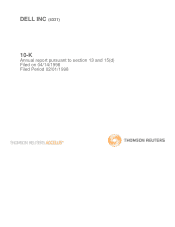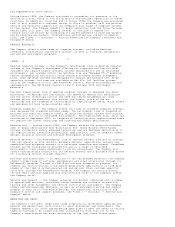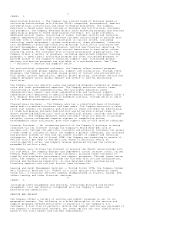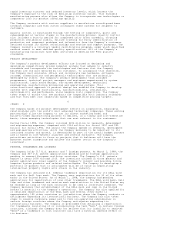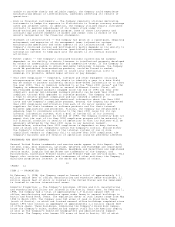Dell 1997 Annual Report Download - page 8
Download and view the complete annual report
Please find page 8 of the 1997 Dell annual report below. You can navigate through the pages in the report by either clicking on the pages listed below, or by using the keyword search tool below to find specific information within the annual report.The Company has entered into a variety of licensing and cross-licensing
agreements pursuant to which the Company licenses various patented hardware
technology. In addition, the Company has entered into non-exclusive licensing
agreements with Microsoft Corporation for various operating system and
application software. The Company has also entered into various other software
licensing agreements with other companies.
From time to time, other companies and individuals assert exclusive patent,
copyright, trademark or other intellectual property rights to technologies or
marks that are important to the computer industry or the Company's business. The
Company evaluates each claim relating to its products and, if appropriate, seeks
a license to use the protected technology. The licensing agreements generally do
not require the counterparty to assist the Company in duplicating its patented
technology nor do these agreements protect the Company from trade secret,
copyright or other violations by the Company or its suppliers in developing or
selling these products.
INFRASTRUCTURE
Management Information Systems -- The Company's management information systems
enable the Company to track each unit sold from the initial sales contacts,
through the manufacturing process
7
<PAGE> 9
to post-sale service and support. The system assists the Company in tracking key
information about many of its customers. The Company is able to target marketing
activities specifically to particular types of customers using its database to
assess purchasing trends, advertising effectiveness and customer and product
groupings. This database, unique to the Company's direct model, allows the
Company to gauge customer satisfaction issues and also provides the opportunity
to test new propositions in the marketplace prior to product or service
introductions. The Company continually analyzes updates and enhancements of its
management information systems to more fully integrate them on an
enterprise-wide basis, to reduce redundancy and to incorporate enhanced
functionality.
Employees -- At February 1, 1998, the Company had approximately 16,000
employees. Approximately 11,000 of those employees were located in the United
States, and approximately 5,000 were located in other countries. The Company has
never experienced a work stoppage due to labor difficulties and believes that
its employee relations are good.
GOVERNMENT REGULATION
In the United States, the Federal Communications Commission (the "FCC")
regulates the radio frequency emissions of computing equipment. The FCC has
established two standards for computer products, Class A and Class B. Only Class
B products may be sold for use in a residential environment. Both Class A and
Class B products may be sold for use in a commercial environment. All of the
Company's current desktop, notebook, workstation and network server systems are
sold under the more restrictive Class B certification. The Company periodically
tests its products to ensure that the products satisfy applicable FCC
regulations.
The Company's business also is subject to regulation by various other federal
and state governmental agencies. Such regulation includes the anti-trust
regulatory activities of the U.S. Federal Trade Commission and Department of
Justice, the import/export regulatory activities of the U.S. Department of
Commerce and the product safety regulatory activities of the U.S. Consumer
Products Safety Commission.
The Company also is required to obtain regulatory approvals in other countries
prior to the sale or shipment of products. In certain jurisdictions, such
requirements are more stringent than in the United States. Many developing
nations are just beginning to establish safety, environmental and other
regulatory requirements, which may vary greatly from U.S. requirements.
BACKLOG
At the end of fiscal 1998, backlog was $215 million, compared with backlog of
$222 million at the end of fiscal 1997. The Company does not believe that
backlog is a meaningful indicator of sales that can be expected for any period,
and there can be no assurance that the backlog at any point in time will
translate into sales in any subsequent period, particularly in light of the
Company's policy of allowing customers to cancel or reschedule orders without
penalty prior to commencement of manufacturing.
FACTORS AFFECTING THE COMPANY'S BUSINESS AND PROSPECTS
There are many factors that affect the Company's business and the results of its
operations, some of which are beyond the control of the Company. The following
is a description of some of the important factors that may cause the actual
results of the Company's operations in future periods to differ materially from
those currently expected or desired.

